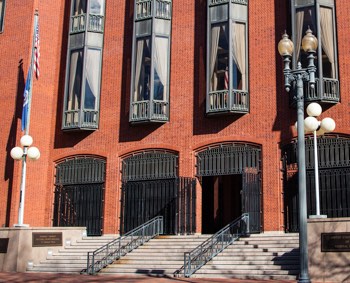 Bamberg v. Dalvey, (Fed. Cir. Mar. 9, 2016) (Before Moore, Hughes, and Stoll, J.) (Opinion for the court, Hughes, J.). Click Here for a copy of the opinion.
Bamberg v. Dalvey, (Fed. Cir. Mar. 9, 2016) (Before Moore, Hughes, and Stoll, J.) (Opinion for the court, Hughes, J.). Click Here for a copy of the opinion.
Dalvey is the owner of four patents disclosing a method for a transfer of printed images onto dark colored textiles by ironing over a specialty paper. The specialty paper contains a removable substrate coated with silicon, a hot-melt adhesive, a white layer, and an ink-receptive layer. Bamberg believed it was the earlier inventor of these claims and that Dalvey had copied its claims into four patent applications in order to provoke an interference proceeding. The Board initiated three interferences and declared Bamberg the senior party. Dalvey filed a motion alleging that Bamberg’s claims were unpatentable for lack of written description under 35 U.S.C. § 112. Dalvey argued that the copied claims recited a white layer that melted at a wide range of temperatures, but Bamberg’s specification disclosed that the layer did not melt below 220 degrees Celsius.
The Board held that the copied claims must be given their broadest reasonable interpretation in light of the Dalvey specification. Dalvey’s specification defines “white layer” as a layer positioned between a release layer and a receiving layer that imparts a white background on a dark substrate. The specification discloses embodiments where the white layer melts at different temperatures, including a range of 43-300 degrees Celsius. Thus, the claims encompass a white layer that melts below 220 degrees Celsius. However, the Bamberg specification did not go below 220 degrees and did not meet the written description requirement for the full scope of the claims copied from Dalvey. Dalvey’s motion was granted and Bamberg appealed.
[Troutman-Ad]
Bamberg argued that the Board improperly imported a functional limitation in the claims by requiring that the white layer melt below 220 degrees Celsius. Siding with Dalvey, the Court found no error in the Board’s conclusion that the broadest reasonable interpretation of “white layer” included a white layer that melted both above and below 220 degrees Celsius.
The Court noted that Bamberg’s specification must also support this construction to satisfy the written description requirement. Bamberg’s specification stated that plastics must not melt at ironing temperatures (up to above 220 degrees Celsius) because the effects would be undesired. Bamberg argued that while this was in the specification, the written description requirement was satisfied because one skilled in the art would understand that one could have a layer that melted above and below 220 degrees Celsius, but both may not be desired. The Court held there was insufficient evidence on the record to support the conclusion that Bamberg possessed a white layer that melted below 220 degrees Celsius because it specifically distinguished this as an undesired result.
Bamberg also appealed the Board’s denial of its motion to amend its claims in response to Dalvey’s motion. The Court found the Board’s decision was not an abuse of discretion. Because Bamberg did not provide a claim chart to determine if it met its burden of establishing that the proposed claims were supported by the written description, it failed to comply with the regulations of interference proceedings. For these reasons, the Court affirmed the Board’s decision.
Also contributing to this summary were Lindsay Henner, Parker Hancock, and Puja Dave.
[Troutman-About]

![[IPWatchdog Logo]](https://ipwatchdog.com/wp-content/themes/IPWatchdog%20-%202023/assets/images/temp/logo-small@2x.png)


![[Advertisement]](https://ipwatchdog.com/wp-content/uploads/2024/04/Patent-Litigation-Masters-2024-sidebar-early-bird-ends-Apr-21-last-chance-700x500-1.jpg)

![[Advertisement]](https://ipwatchdog.com/wp-content/uploads/2021/12/WEBINAR-336-x-280-px.png)
![[Advertisement]](https://ipwatchdog.com/wp-content/uploads/2021/12/2021-Patent-Practice-on-Demand-recorded-Feb-2021-336-x-280.jpg)
![[Advertisement]](https://ipwatchdog.com/wp-content/uploads/2021/12/Ad-4-The-Invent-Patent-System™.png)







Join the Discussion
No comments yet.